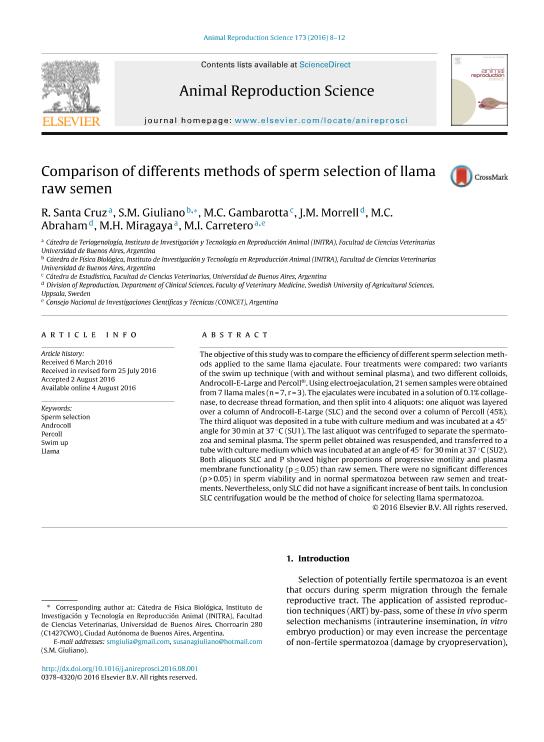Mostrar el registro sencillo del ítem
dc.contributor.author
Santa Cruz, R.
dc.contributor.author
Giuliano, S. M.
dc.contributor.author
Gambarotta, M. C.
dc.contributor.author
Morrell, J. M.
dc.contributor.author
Abraham, M. C.
dc.contributor.author
Miragaya, Marcelo

dc.contributor.author
Carretero, Maria Ignacia

dc.date.available
2020-11-04T20:56:37Z
dc.date.issued
2016-10
dc.identifier.citation
Santa Cruz, R.; Giuliano, S. M.; Gambarotta, M. C.; Morrell, J. M.; Abraham, M. C.; et al.; Comparison of differents methods of sperm selection of llama raw semen; Elsevier Science; Animal Reproduction Science; 173; 10-2016; 8-12
dc.identifier.issn
0378-4320
dc.identifier.uri
http://hdl.handle.net/11336/117653
dc.description.abstract
The objective of this study was to compare the efficiency of different sperm selection methods applied to the same llama ejaculate. Four treatments were compared: two variants of the swim up technique (with and without seminal plasma), and two different colloids, Androcoll-E-Large and Percoll®. Using electroejaculation, 21 semen samples were obtained from 7 llama males (n = 7, r = 3). The ejaculates were incubated in a solution of 0.1% collagenase, to decrease thread formation, and then split into 4 aliquots: one aliquot was layered over a column of Androcoll-E-Large (SLC) and the second over a column of Percoll (45%). The third aliquot was deposited in a tube with culture medium and was incubated at a 45° angle for 30 min at 37 °C (SU1). The last aliquot was centrifuged to separate the spermatozoa and seminal plasma. The sperm pellet obtained was resuspended, and transferred to a tube with culture medium which was incubated at an angle of 45° for 30 min at 37 °C (SU2). Both aliquots SLC and P showed higher proportions of progressive motility and plasma membrane functionality (p ≤ 0.05) than raw semen. There were no significant differences (p > 0.05) in sperm viability and in normal spermatozoa between raw semen and treatments. Nevertheless, only SLC did not have a significant increase of bent tails. In conclusion SLC centrifugation would be the method of choice for selecting llama spermatozoa.
dc.format
application/pdf
dc.language.iso
eng
dc.publisher
Elsevier Science

dc.rights
info:eu-repo/semantics/openAccess
dc.rights.uri
https://creativecommons.org/licenses/by-nc-sa/2.5/ar/
dc.subject
ANDROCOLL
dc.subject
LLAMA
dc.subject
PERCOLL
dc.subject
SPERM SELECTION
dc.subject
SWIM UP
dc.subject.classification
Otras Ciencias Veterinarias

dc.subject.classification
Ciencias Veterinarias

dc.subject.classification
CIENCIAS AGRÍCOLAS

dc.title
Comparison of differents methods of sperm selection of llama raw semen
dc.type
info:eu-repo/semantics/article
dc.type
info:ar-repo/semantics/artículo
dc.type
info:eu-repo/semantics/publishedVersion
dc.date.updated
2020-09-03T16:53:32Z
dc.journal.volume
173
dc.journal.pagination
8-12
dc.journal.pais
Países Bajos

dc.journal.ciudad
Amsterdam
dc.description.fil
Fil: Santa Cruz, R.. Universidad de Buenos Aires. Facultad de Ciencias Veterinarias. Instituto de Investigacion y Tecnología en Reproducción Animal; Argentina
dc.description.fil
Fil: Giuliano, S. M.. Universidad de Buenos Aires. Facultad de Ciencias Veterinarias. Instituto de Investigacion y Tecnología en Reproducción Animal; Argentina
dc.description.fil
Fil: Gambarotta, M. C.. Universidad de Buenos Aires. Facultad de Ciencias Veterinarias; Argentina
dc.description.fil
Fil: Morrell, J. M.. Swedish University Of Agricultural Sciences. Faculty Of Veterinary Medicine And Animal Science; Suecia
dc.description.fil
Fil: Abraham, M. C.. Swedish University Of Agricultural Sciences. Faculty Of Veterinary Medicine And Animal Science; Suecia
dc.description.fil
Fil: Miragaya, Marcelo. Universidad de Buenos Aires. Facultad de Ciencias Veterinarias. Instituto de Investigacion y Tecnología en Reproducción Animal; Argentina
dc.description.fil
Fil: Carretero, Maria Ignacia. Universidad de Buenos Aires. Facultad de Ciencias Veterinarias. Instituto de Investigacion y Tecnología en Reproducción Animal; Argentina. Consejo Nacional de Investigaciones Científicas y Técnicas; Argentina
dc.journal.title
Animal Reproduction Science

dc.relation.alternativeid
info:eu-repo/semantics/altIdentifier/doi/http://dx.doi.org/10.1016/j.anireprosci.2016.08.001
dc.relation.alternativeid
info:eu-repo/semantics/altIdentifier/url/https://www.sciencedirect.com/science/article/abs/pii/S0378432016303037
Archivos asociados
